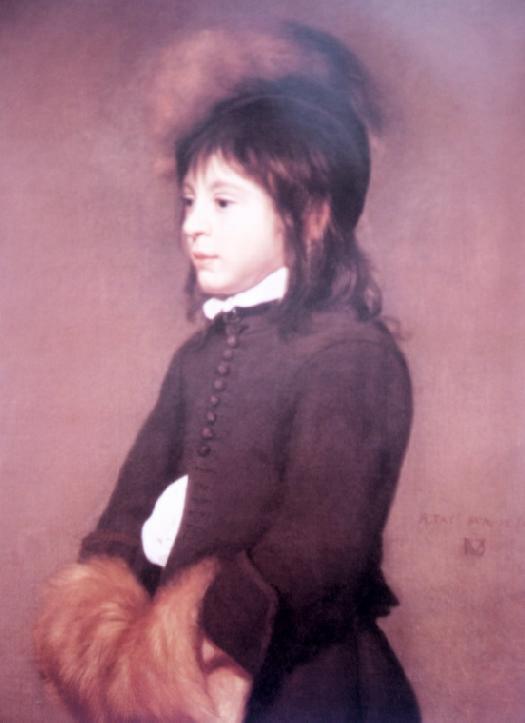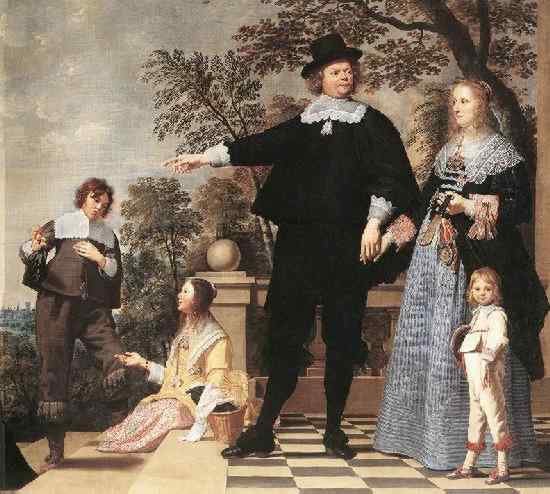
Artists Illustrating Boys' Fashions: Jacob Van Oost the Elder (Flanders-Belgium, 1601-71)

Figure 1.--The painting by Jacob Van Oost shown here shows a coat worn in the 17 and 18th centuries. The image is unclear, but it looks to be a short coat. The boy wears a muted colored brown coat. The boy has long shoulder-length hair which has not been curled. His father may have worn a wig.
|
|
Relatively little information is available on the life of Flemish master Jacob van Oost. He became a master in the Bruges guild of St. Luke in 1621. Three decades later he was appointed the official painter of the city of Bruges in 1651. Burges was at the center of the Flemish economic expansion in the 17th century. Van Oost held this position until he died in 1671. A few of his paintings show fascinating images of the way children were dressed in the rich city of Byrges. Van Oost not only left individual portraits, but some especially fine family portraits, a genre in which he was especially effective.
Bruges
The city of Bruges has a facinating history and was at the heart of the development of the modern European economy. The art suported by the wealth of Bruges leases a wonderful record of the clothing and culture of Europe as it made the transition from the Medevil to the modern world. At the time of Jacob van Oost in the 17th century, Bruges had declined from its once dominant position in the economy of northern Europe, but was still a prosperoud provincial city.
Bruges in the Middle Ages became the most important trade centre of north-west Europe. Flanders had become one of the most urbanised areas in Europe. The Flemish became renounded for producing high quality woollen material. It was exported from Bruges throughout Europe. Bruges during the 13th-15th centuries Bruges had a population from 40,000 and 45,000 peole, making it at the time a major European city. It was double the current population in the historic inner city. By the 14th century Bruges had expanded to become a rich international
port city--the most prosperous city in northern Europe. Merchants from northern and southern Europe brough their products to Bruges. To conduct buiness they used Bruges brokers and landlords. Economic activity in Bruges was not limited to the weaving of Flemish cloth, but all kinds of other trades developed. European banking comes from Italy, the word itself comes from the benches where early banking was conducted. Bruges was an early center of banking in northern Europe. In Bruges during the 14th century there were bankers operating, both natives Bruges bankers as wll as Italians. Merchants could thus open an account in Bruges, transfer large sums, change money and even pay with notes. Art and culture flourished as never before.
The goldn age of Bruges and indeed Flanders ended with the unexpected death of Mari of Burgundy in 1482. The revolt against her widower, Maximilian of Austria, meant that Bruges suffered political uncertainty and military occupation for 10 years. The prosperity that a stable economic and political culture disappeared, The Burgundian court and the international traders left the city. Antwerp replaced Bruges in importance. Bruges recovered somewhat in the 16th century. But the city had clearly lost its leading position to Antwerp. Bruges, while no longer dominant, remained important as a regional centre with international commercial contacts and a flourishing art sector. Bruges was split from the Netherlands in 1584, which caused a declinr from which Bruges never fully recovered.
Bruges by the beginning of the 17th was a provincial city with a modest maritime reputation. The Bruges merchant spirit had still not
disappeared in the 17th and 18th centuries. Commercial life had international roots. Bruges shipowners and merchants still traded with the Spanish empire, England and the East and West Indies.
Personal Life
We know virtually nothing about Van Oost's personal life. We do know that his son, Jacob's son, Jacob van Oost the Younger (1639-1713), also painted. His style was more difuse. Most of his work was done in Lille.
Body of Work
Van Oost was greatly influenced by Italy masters. He lived several years prior to 1628. Two of the most important influences appear to be Caravaggio and Carracci. Besides altarpieces, Van Oost painted numerous portraits. His family portaits are especially renowned. Perhaps the most celebrated is "Portrait of a Bruges Family" (1645) shown here.
Portrait of a Boy
The painting shown above, "Portrait of a Boy aged 11", was painted by Jacob van Oost the Elder, although we do not know the date. It looks to have been painted in the mid-17th century. It is in the tradition of Dutch and Flemish artists. Many recorded children as real people. This portrait of an 11-year old boy is a wonderful character study.
Clothing Styles
The painting is unclear, but the boy wears what looks to be a short caot. There are some stylistic similarities with the long coats worn in the 18th century. This boy wears a muted colored brown coat. Note the fabric covered button and how closely spaced the buttons are. Also note the large cuffs detailed with a diferent, darker material. This coat would have been essentially the same garment that the boy's father would have worn. Unfortunately details of the white collar are difficult to make out. Note the fur muff which in the 17th century were used by both boys and girls.
Hair
The boy has long shoulder-length hair which has not been curled. His father probably wore a wig. The fact that his father could aford a childhood portrait means that he must have been quite well off. This suggests that he likely also wore a wig. Boys might also wear wigs, but they were less common.

Figure 2.--The painting by Jacob Van Oost shown here shows a Bruges family in 1645.
|
|
Portrait of a Burges Family (1645)
One of van Oost's most celebrated paintings is "Portrait of a Burges Family ". The artist wmployed a pictorial technique which is strongly displayed in this potrait. We do not know the identity of the family, but we can assume that it is a pprosperous merchant family. The black clothes of the father suggest to HBC that he is not an aristocrat. Van Oost has displayed the family in lively posture. Note the playful glances. Their clothing, lit by bright sunlight, is painted in great detail. Interestingly, van Oost has signed and dated the portrait on the lower right on the parapet. The age of the various figures is reportedly indicated on an item of clothing or an object, although HBC is unable to make them out. The family includes three childrem, two boys, 1 girl, and an unidentified baby (not shown in this cropped view of the painting).
Art experts presumably know the ages of the boys. It is a little difficult to estimate as the persoective does not seem quite right. For example the head of youngr children is a larger part of their body size than adults. The head of the younger boy, however, is painted in the proportioin of an adult. The fact that he has been breeched suggests that he is probably abot 6 or 7 yeras old. There are many similarities with the out fits worn by his old brother and father. Each wear suits with short jackets, fancy collars and cuff trim, and knickerbocker pants. There are also important differences. The mlost obvious is the light color, more like his mothers' and sister's outfits than the subdued darker colors worn by his older brother and father. Also his knickerbockers are worm longer than those of his father's pants. Note the red trim on the hem of his knickers. His hair is worn long, somewhat longer than his older brother, but not curled.
Again because of our concern over the lack of accurate perspective, it is difficult to assess the age of the older brother. We are guessing that he is a younger teenager, in part because we do not think that there ould be a 10-year gap in the ages of the children. The older brother's outfit is quite similar to that of his father. The boy wears a coat of subdued color, although brown rather thank black. Both wear large collars and matching cuff trim. The boy's collat, however, appears toi be a solid square white collar rather than the fine lace his father wears. Note the white trim on the hem of the knickets. His father also looks to have trim at the mem pf his knickers, but ot looks to be black and thus difficult to make out.
Christopher Wagner

Navigate the Boys' Historical Clothing Artists pages:
[Return to Main Artists S-Z page]
[Chronology]
[Countries]
[Individuals]
[Styles]
Navigate the Boys' Historical Clothing Web Site:
[About Us]
[Introduction]
[Activities]
[Bibliographies]
[Biographies]
[Chronology]
[Clothing styles]
[Countries]
[Contributions]
[FAQs]
[Glossaries]
[Images]
[Links]
[Registration]
[Tools]
[Boys' Clothing Home]
Created: January 26, 2002
Last updated: January 26, 2002




